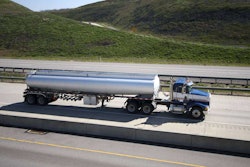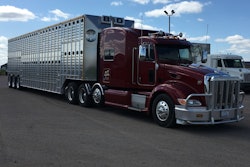 State-to-state harmonization challenges persist for specialized carriers, and new to the mix in recent years are priorities placed on advocating for hours of service flexibilities. That's one of the messages that came out of a panel discussion March 1 moderated by (right) Oxbo's Keith Settle with (from left) Jennifer Schuster of Edwards Moving and Rigging; Intermountain's Ron Montgomery; Brett Berard of Berard Transport; Precision Specialized's Ed Bernard; and Bennett CEO David Lowry.
State-to-state harmonization challenges persist for specialized carriers, and new to the mix in recent years are priorities placed on advocating for hours of service flexibilities. That's one of the messages that came out of a panel discussion March 1 moderated by (right) Oxbo's Keith Settle with (from left) Jennifer Schuster of Edwards Moving and Rigging; Intermountain's Ron Montgomery; Brett Berard of Berard Transport; Precision Specialized's Ed Bernard; and Bennett CEO David Lowry.
The hours of service regulations have been a perennial hot topic of debate among owner-operators and other drivers for decades now. Since the dawn of the electronic logging device mandate in late 2017, that debate has only heated up, branching into most every trucking segment and leading the way toward changes designed to increase split-rest flexibility in 2020, among other tweaks. But at last week's Specialized Transportation Symposium in Orlando, Florida, a meeting of the transport-focused members of the Specialized Carriers and Rigging Association (SCRA), heavy-specialized carrier execs noted continued challenges associated with operators' available hours, particularly when it comes to so-called "super loads" requiring intricate planning, extensive permitting and often conflicting scheduling -- sometimes changing at the drop of a hat at any given state line.
Permitting harmonization between states has long been an advocacy project of the association, with much progress made in that regard over the 75 years SCRA's been in existence. Yet there are still times when a permitted load restricted to daylight-only travel arrives at a state border to find itself restricted to late-night-only movement on the other side. For Brett Berard, operations vice president with Louisiana-headquartered Berard Transport, it often feels like "we’ll never get to a point where it’s easy to [transport over] borders between states," and permitting authorities' indecisiveness in the planning process only complicates matters. "In one instance," he added, one such authority "made a change" in a day/night restriction with just a few weeks to spare on a complicated, intricate super load plan.
Berard was speaking as part of the opening panel discussion around specialized-transport challenges that began the symposium's education session on March 1.
Operators' hours of service in such a scenario can be particularly "tough to deal with," said Ron Montgomery of Intermountain Rigging and Heavy Haul, as planners struggle to get the right people in the right place, with the right amount of hours, to complete the most complex of moves within sometimes tight time frames on the permits. "ELDs have really impacted heavy haul," he added, foregrounding the hard duty limitations of the hours of service. In the run-up to implementation of the ELD mandate in 2017, SCRA requested and was granted an exemption from the requirement to take a 30-minute break after eight duty hours (since 2020 eight driving hours). That exemption came with regulators' recognition of the incompatibility of the requirement with operational challenges of finding a safe place to park with an oversize move, limitations with curfew hours particularly in wintertime, and more.
"We’re pretty safe" compared to the greater population of motor carriers, Montgomery added about heavy-specialized haulers on the whole. "Fatigue isn’t really much of an issue with heavy-haul loads." Hours of service rules as they are, he felt, "have made our industry's [work] tough to officially do."
[Related: ELDs and highway safety: Crashes, injuries, fatalities rise post-mandate]










